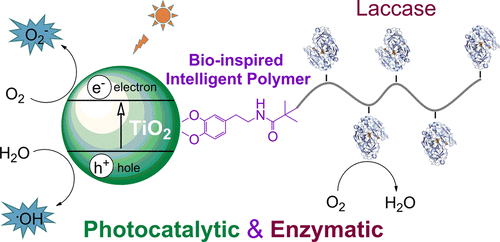当前位置:
X-MOL 学术
›
Biomacromolecules
›
论文详情
Our official English website, www.x-mol.net, welcomes your feedback! (Note: you will need to create a separate account there.)
Coating Titania Nanoparticles with Epoxy-Containing Catechol Polymers via Cu(0)-Living Radical Polymerization as Intelligent Enzyme Carriers
Biomacromolecules ( IF 6.2 ) Pub Date : 2018-05-08 00:00:00 , DOI: 10.1021/acs.biomac.8b00544 Donghao Wang 1, 2 , Wenyi Ding 1, 2 , Kaiyue Zhou 1, 2 , Shutong Guo 1, 2 , Qiang Zhang 1, 2 , David M. Haddleton 3
Biomacromolecules ( IF 6.2 ) Pub Date : 2018-05-08 00:00:00 , DOI: 10.1021/acs.biomac.8b00544 Donghao Wang 1, 2 , Wenyi Ding 1, 2 , Kaiyue Zhou 1, 2 , Shutong Guo 1, 2 , Qiang Zhang 1, 2 , David M. Haddleton 3
Affiliation

|
Immobilization of enzyme could offer the biocatalyst with increased stability and important recoverability, which plays a vital role in the enzyme’s industrial applications. In this study, we present a new strategy to build an intelligent enzyme carrier by coating titania nanoparticles with thermoresponsive epoxy-functionalized polymers. Zero-valent copper-mediated living radical polymerization (Cu(0)-LRP) was utilized herein to copolymerize N-isopropylacrylamide (NIPAM) and glycidyl acrylate (GA) directly from an unprotected dopamine-functionalized initiator to obtain an epoxy-containing polymer with terminal anchor for the “grafting to” or “one-pot” modification of titania nanoparticles. A rhodamine B-labeled laccase has been subsequently used as a model enzyme for successful immobilization to yield an intelligent titania/laccase hybrid bifunctional catalyst. The immobilized laccase has shown excellent thermal stability under ambient or even relatively high temperature above the lower critical solution temperature (LCST) at which temperature the hybrid particles could be facilely recovered for reuse. The enzyme activity could be maintained during the repeated use after recovery and enzymatic degradation of bisphenol A was proven to be efficient. The photocatalytic ability of titania was also investigated by fast degradation of rhodamine B under the excitation of simulated sunlight. Therefore, this study has provided a facile strategy for the immobilization of metal oxide catalysts with enzymes, which constructs a novel bifunctional catalyst that will be promising for the “one-pot” degradation of different organic pollutants.
中文翻译:

通过含Cu(0)的自由基聚合作为智能酶载体,用含环氧的邻苯二酚聚合物涂覆二氧化钛纳米颗粒。
固定化酶可以为生物催化剂提供更高的稳定性和重要的可回收性,这在酶的工业应用中起着至关重要的作用。在这项研究中,我们提出了一种通过用热响应性环氧官能化聚合物涂覆二氧化钛纳米颗粒来构建智能酶载体的新策略。本文利用零价铜介导的活性自由基聚合(Cu(0)-LRP)来共聚合N-异丙基丙烯酰胺(NIPAM)和丙烯酸缩水甘油酯(GA)直接从未保护的多巴胺官能化引发剂中获得带有末端锚定物的含环氧基聚合物,用于“接枝”或“单锅”修饰二氧化钛纳米颗粒。罗丹明B标记的漆酶随后已用作成功固定化的模型酶,以产生智能的二氧化钛/漆酶杂化双功能催化剂。固定化的漆酶在高于或低于较低临界溶液温度(LCST)的环境温度下甚至相对较高的温度下均显示出优异的热稳定性,在该温度下可以方便地回收杂化颗粒以进行再利用。回收后,在重复使用过程中可以保持酶活性,双酚A的酶促降解被证明是有效的。还通过在模拟阳光的激发下罗丹明B的快速降解来研究二氧化钛的光催化能力。因此,这项研究为用酶固定金属氧化物催化剂提供了一种简便的策略,该酶构建了一种新型的双功能催化剂,有望对不同有机污染物进行“一锅法”降解。
更新日期:2018-05-08
中文翻译:

通过含Cu(0)的自由基聚合作为智能酶载体,用含环氧的邻苯二酚聚合物涂覆二氧化钛纳米颗粒。
固定化酶可以为生物催化剂提供更高的稳定性和重要的可回收性,这在酶的工业应用中起着至关重要的作用。在这项研究中,我们提出了一种通过用热响应性环氧官能化聚合物涂覆二氧化钛纳米颗粒来构建智能酶载体的新策略。本文利用零价铜介导的活性自由基聚合(Cu(0)-LRP)来共聚合N-异丙基丙烯酰胺(NIPAM)和丙烯酸缩水甘油酯(GA)直接从未保护的多巴胺官能化引发剂中获得带有末端锚定物的含环氧基聚合物,用于“接枝”或“单锅”修饰二氧化钛纳米颗粒。罗丹明B标记的漆酶随后已用作成功固定化的模型酶,以产生智能的二氧化钛/漆酶杂化双功能催化剂。固定化的漆酶在高于或低于较低临界溶液温度(LCST)的环境温度下甚至相对较高的温度下均显示出优异的热稳定性,在该温度下可以方便地回收杂化颗粒以进行再利用。回收后,在重复使用过程中可以保持酶活性,双酚A的酶促降解被证明是有效的。还通过在模拟阳光的激发下罗丹明B的快速降解来研究二氧化钛的光催化能力。因此,这项研究为用酶固定金属氧化物催化剂提供了一种简便的策略,该酶构建了一种新型的双功能催化剂,有望对不同有机污染物进行“一锅法”降解。


























 京公网安备 11010802027423号
京公网安备 11010802027423号